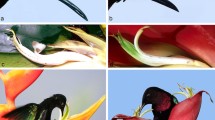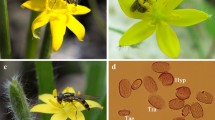Summary
We present results of experiments designed to identify floral characteristics that influence patterns of pollen carryover by hummingbirds visiting Ipomopsis aggregata flowers. We used fluorescent dye powders as pollen analogues. For all four experimental treatments considered, amounts of dye deposited on recipient stigmas declined linearly as a function of flower position in a visitation sequence. The decline was significantly steeper when recipient flowers had pollen-carrying anthers than when they did not; whereas degree of stigma clogging and presence or absence of empty anthers did not influence carryover. From this we conclude that presence of pollen on recipient flowers significantly reduces the average number of subsequent flowers reached by donor pollen. We discuss mechanisms for this effect and its significance for the evolution of floral structure.
Similar content being viewed by others
References
Beattie AJ (1976) Plant dispersion, pollination, and gene flow in Viola. Oecologia 25:291–300
Charnov EL (1979) Simultaneous hermaphroditism and sexual selection. Proc Natn Acad Sci USA 76:2480–2484
Lertzman KP (1981) Pollen transfer: processes and consequences. Masters thesis, Univ of British Columbia, Vancouver
Lertzman KP, Gass CL (1982) Alternative models of pollen transfer. In: CE Jones and RJ Little (eds) Handbook of experimental pollination biology, Van Nostrand Reinhold, New York, in press
Levin DA, Berube DE (1972) Phlox and Colias: the efficiency of a pollination system. Evolution 26:242–250
Levin DA, Kerster HW (1968) Local gene dispersal in Phlox. Evolution 22:130–139
Levin DA, Kerster HW (1969). The dependence of bee-mediated pollen and gene dispersal upon plant density. Evolution 23:560–571
Linhart YB, Feinsinger P (1980) Plant-hummingbird interactions: effects of island size and degree of specialization on pollination. J Ecol 68:745–760
Morse DH (1982) Patterns of pollinia accretion and loss on bumblebees, and their implications for outcrossing. Evolution (in review)
Perkins MDC (1977) Dynamics of hummingbird mediated pollen flow in a subalpine meadow. Masters thesis, Univ of British Columbia, Vancouver
Price MV, Waser NM (1979) Pollen dispersal and optimal outcrossing in Delphinium nelsoni. Nature 277:294–296
Pyke GH (1979) Optimal foraging in bumblebees: rule of movement between flowers within inflorescences. Anim Behav 27:1167–1181
Pyke GH (1981) Optimal foraging in nectar-feeding animals and coevolution with their plants. In: AC Kamil and TD Sargent (eds) Foraging behavior: ecological, ethological, and psychological approaches, Garland, New York
Schaal BA (1980) Measurement of gene flow in Lupinus texensis. Nature 284:450–451
Schmitt J (1980) Pollinator foraging behavior and gene dispersal in Senecio (Compositae). Evolution 34:934–943
Snedecor GW, Cochran WG (1967) Statistical methods. Iowa State Univ Press, Ames
Thomson JD (1980) Skewed flowering distributions and pollinator attraction. Ecology 61:572–579
Thomson JD, Plowright RC (1980) Pollen carryover, nectar rewards, and pollinator behavior with special reference to Diervilla lonicera. Oecologia 46:68–74
Turner NE, Stephens JC, Anderson WW (1981) Homozygosity and patch structure in plant populations as a result of nearest neighbor pollination. Proc Natn Acad Sci USA 79:203–207
Waddington KD (1981) Factors influencing pollen flow in bumblebee-pollinated Delphinium virescens. Oikos 37:153–159
Waser NM (1978a) Competition for hummingbird pollination and sequential flowering in two Colorado wildflowers. Ecology 59:934–944
Waser NM (1978b) Interspecific pollen transfer and competition between co-occuring plant species. Oecologia 36:223–236
Waser NM (1982) A comparison of distances flown by different visitors to flowers of the same species. Oecologia, in review
Waser NM, Price MV (1981) Pollinator choice and stabilizing selection for flower color in Delphinium nelsonii. Evolution 35:376–390
Waser NM, Price MV (1982a) A comparison of pollen and fluorescent dye carryover by natural pollinators of Ipomopsis aggregata (Polemoniaceae). Ecology, in press
Waser NM, Price MV (1982b) Optimal and actual outcrossing in plants, and the nature of plant-pollinator interaction. In: CE Jones and RJ Little (eds) Handbook of experimental pollination biology, Van Nostrand Reinhold, New York, in press
Author information
Authors and Affiliations
Rights and permissions
About this article
Cite this article
Price, M.V., Waser, N.M. Experimental studies of pollen carryover: Hummingbirds and Ipomopsis aggregata . Oecologia 54, 353–358 (1982). https://doi.org/10.1007/BF00380004
Received:
Issue Date:
DOI: https://doi.org/10.1007/BF00380004




